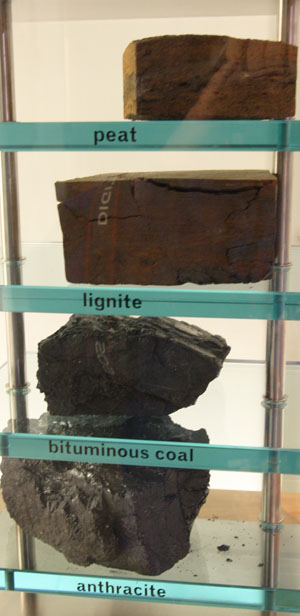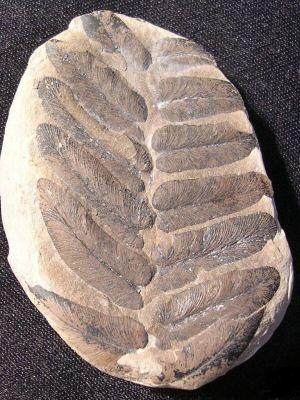Coal Grades
Coal is formed from ancient vegetation. The Yorks and North Notts seams were laid down in river deltas aboute 270-300 million years ago (the Carboniferous era) and compressed as they were buried via geological processes.
Coal rank Coals can be graded by Rank - the higher the rank the more carbon and the less the water content (and other contaminants). Higher ranked coals give off the most energy when burnt.
Generally, the deeper the coal the higher the rank - peat is at surface, is very moist and full of the oils and chemicals from the vegetation from which it formed. Lignite (also called Brown Coal) is peaty material that has been metamorphosed into the lowest rank of coal. Lignite is generally brown, soft, and moist. Anthracite hard and shiney and has a high carbon and the highest energy content - it has been 'cooked' at depth at that drives off much of the water and other volatile stuff. Generally, the deeper the coal the higher the rank (google Hilt's Law).
Coals can be graded by Rank - the higher the rank the more carbon and the less the water content (and other contaminants). Higher ranked coals give off the most energy when burnt.
Generally, the deeper the coal the higher the rank - peat is at surface, is very moist and full of the oils and chemicals from the vegetation from which it formed. Lignite (also called Brown Coal) is peaty material that has been metamorphosed into the lowest rank of coal. Lignite is generally brown, soft, and moist. Anthracite hard and shiney and has a high carbon and the highest energy content - it has been 'cooked' at depth at that drives off much of the water and other volatile stuff. Generally, the deeper the coal the higher the rank (google Hilt's Law).
Chemical composition
Most of the Yorks coals are bituminous. Some South Wales coals are famously high rank anthracites. Approximate water contents (rounded to nearest whole number) of coal ranks are given below. Water absorbs some of the energy of the coal to drive it off during combustion.
- Anthracite Coal : 3 - 16 weight %
- Bituminous Coal : 8 - 25 %
- Lignite Coal : 30-40 %
Approx % Carbon Content by weight. Burning carbon releases energy:
- Anthracite : 80 - 87
- Bituminous : 45 -78
- Lignite : 60-71
Approx % 'volatiles' by weight. The more volatiles the more smoke and soot:
- Anthracite : 3 - 9
- Bituminous : 10- 36
- Lignite : more than 36
Typical energy values, in kj/kg:
- Anthracite : 36000
- Bituminous : 35000
- Lignite : 25000
- Peat : 17000
Note that there's a large variability in these guide numbers - each coal seam has unique properties. The cutoff points between one grade and another are fairly arbritary - lignite doesn't suddenly flip into another state when the moisture drops below 35%. There are sub divisions within the ranks to - sub-bituminous lies between lignite and 'full' bituminous for example.
Other components are stuff like sulpher, which can cause acid rain (dilute suplphuric acid) if ejected straight into the air from a power station flue. For this reason modern power plants should have gas scrubbers that remove the sulpher.
Main classifications of coal (peat is 'pre-coal' really).
Coal is still being formed today, although at geologically slow rates; maybe 10,000 years for enough vegetation for a 1m seam, which then has be to buried and compressed for millions of years. So, effectively we have all the coal we are ever going to get. The coal measures were comprised of trees that were giant ferns; not the flowering trees or pines that exist on earth today (although small ferns that are relatives of the carboniferous giants have survived). They were laid down in river deltas 270-300 million years ago and compressed as they were buried via geological processes.

Fossil of the type of fern that formed the Yorks Carboniferous coal measures.
Typical Uses
Lignite is used mostly as a fuel for electric power generation. A large proportion of the worlds electricity is still generated by burning coal.
Bituminous coal is also used as fuel in steam-electric power generation, although better quality forms were widely used as 'steam coal' for ships and steam trains, or as domestic heating coal. Metallurgical coke can also be made from bituminous coals.
Heating lignite and bituminous coals in an oxygen starved atmosphere, e.g. in coke ovens, can produce useful by-products such as naptha that is used as a liquid fuel, or as a solvent in paints , varnishes, shoe polish, etc.
Before North Sea gas the hydrogen rich gasses produced by 'cooking' bituminous coals made Town Gas that was used in Britain for cooking, and lighting (before the advent of electric lights).
Anthracite, because it burns relatively hot and clean is used for home and commercial space heating. It produces the least soot and ash and will boil off less messy volatiles such as naptha. In that respect it is the cleanest coal (if you ignore the CO2).